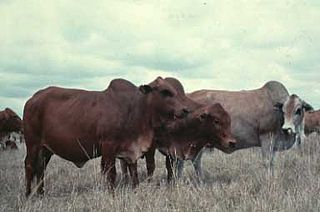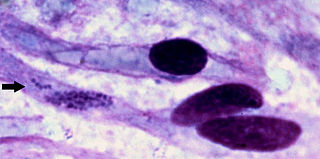Related Research Articles

Tsetse are large, biting flies that inhabit much of tropical Africa. Tsetse flies include all the species in the genus Glossina, which are placed in their own family, Glossinidae. The tsetse is an obligate parasite, which lives by feeding on the blood of vertebrate animals. Tsetse has been extensively studied because of their role in transmitting disease. They have a pronounced economic impact in sub-Saharan Africa as the biological vectors of trypanosomes, causing human and animal trypanosomiasis.
A quantitative trait locus (QTL) is a locus that correlates with variation of a quantitative trait in the phenotype of a population of organisms. QTLs are mapped by identifying which molecular markers correlate with an observed trait. This is often an early step in identifying the actual genes that cause the trait variation.
Jay Laurence Lush was a pioneering animal geneticist who made important contributions to livestock breeding. He is sometimes known as the father of modern scientific animal breeding. Lush received National Medal of Science in 1968 and the Wolf Prize in 1979.

Trypanosoma brucei is a species of parasitic kinetoplastid belonging to the genus Trypanosoma that is present in sub-Saharan Africa. Unlike other protozoan parasites that normally infect blood and tissue cells, it is exclusively extracellular and inhabits the blood plasma and body fluids. It causes deadly vector-borne diseases: African trypanosomiasis or sleeping sickness in humans, and animal trypanosomiasis or nagana in cattle and horses. It is a species complex grouped into three subspecies: T. b. brucei, T. b. gambiense and T. b. rhodesiense. The first is a parasite of non-human mammals and causes nagana, while the latter two are zoonotic infecting both humans and animals and cause African trypanosomiasis.

Trypanosoma evansi is a parasitic species of excavate trypanosome in the genus Trypanosoma that is one cause of surra in animals. Discovered by Griffith Evans in 1880 at Dera Ismail Khan, it is the first known trypanosome that causes infection. It is a common parasite in India and Iran and causes acute disease in camels and horses, and chronic disease in cattle and buffalo. In Pakistan, it has been found to be the most prevalent trypanosome species in donkeys. It is now established to infect other mammals, including humans.

Boran cattle are a popular Zebu beef breed in eastern Africa.
Marker assisted selection or marker aided selection (MAS) is an indirect selection process where a trait of interest is selected based on a marker linked to a trait of interest, rather than on the trait itself. This process has been extensively researched and proposed for plant- and animal- breeding.

Sanga cattle is the collective name for indigenous cattle of some regions in Africa. They are sometimes identified as a subspecies with the scientific name Bos taurus africanus. Their history of domestication and their origins in relation to taurine cattle, zebu cattle (indicine), and native African varieties of the ancestral aurochs are a matter of debate. "African taurine", "sanga", "zenga", "sheko", "African indicine" are all sub-groups of Sanga cattle.

Heartwater is a tick-borne rickettsial disease. The name is derived from the fact that fluid can collect around the heart or in the lungs of infected animals. It is caused by Ehrlichia ruminantium —an intracellular Gram-negative coccal bacterium. The disease is spread by various Amblyomma ticks, and has a large economic impact on cattle production in affected areas. There are four documented manifestations of the disease, these are acute, peracute, subacute, and a mild form known as heartwater fever. There are reports of zoonotic infections of humans by E. ruminantium, similar to other Ehrlichia species, such as those that cause human ehrlichiosis.

Trypanosoma congolense is a species of trypanosomes and is the major pathogen responsible for the disease nagana in cattle and other animals including sheep, pigs, goats, horses and camels, dogs, as well as laboratory mice. It is the most common cause of nagana in east Africa, but is also a major cause of nagana in west Africa. This parasite is spread by tsetse flies. In its mammalian host, Trypanosoma congolense only lives in blood vessels, and causes in particular anaemia.

N'Dama is a breed of cattle from West Africa. Other names for them include Boenca or Boyenca (Guinea-Bissau), Fouta Jallon, Djallonké or Djallonké cattle, Fouta Longhorn, Fouta Malinke, Futa, Malinke, Mandingo (Liberia), and N'Dama Petite (Senegal). Originating in the Guinea highlands, they are also found in southern Senegal, Guinea-Bissau, the Gambia, Mali, Ivory Coast, Liberia, Nigeria, and Sierra Leone. They are trypanotolerant, allowing them to be kept in tsetse fly-infested areas. They also show superior resistance to ticks and the diseases they carry and to Haemonchus contortus stomach worms.
A trypanocidal agent is an antiprotozoal agent that acts upon trypanosome parasites.

Teladorsagia circumcincta is a nematode that is one of the most important parasites of sheep and goats. It was previously known as Ostertagia circumcincta and is colloquially known as the brown stomach worm. It is common in cool, temperate areas, such as south-eastern and south-western Australia and the United Kingdom. There is considerable variation among lambs and kids in susceptibility to infection. Much of the variation is genetic and influences the immune response. The parasite induces a type I hypersensitivity response which is responsible for the relative protein deficiency which is characteristic of severely infected animals. There are mechanistic mathematical models which can predict the course of infection. There are a variety of ways to control the infection and a combination of control measures is likely to provide the most effective and sustainable control.
Molecular breeding is the application of molecular biology tools, often in plant breeding and animal breeding. In the broad sense, molecular breeding can be defined as the use of genetic manipulation performed at the level of DNA to improve traits of interest in plants and animals, and it may also include genetic engineering or gene manipulation, molecular marker-assisted selection, and genomic selection. More often, however, molecular breeding implies molecular marker-assisted breeding (MAB) and is defined as the application of molecular biotechnologies, specifically molecular markers, in combination with linkage maps and genomics, to alter and improve plant or animal traits on the basis of genotypic assays.

Michael Edward "Mike" Goddard is a professorial fellow in animal genetics at the University of Melbourne, Australia.

Daniel Gianola is a geneticist based at the University of Wisconsin-Madison (US), reputed for his contributions in quantitative genetics to the fields of animal and plant breeding. In the early 1980s, Gianola extended best linear unbiased prediction to the non-linear domain for analysis of categorical traits, using the classical threshold model of Sewall Wright. Subsequently, he pioneered the use of Bayesian methodologies and Monte Carlo Markov chain methods in quantitative genetics. He also revived early work by Sewall Wright on structural equation models and cast their application in the context of modern quantitative genetics and statistical methodology. His group in Wisconsin was the first in the world applying non-parametric methods, such as reproducing Kernel Hilbert spaces regression and Bayesian neural networks, to genome-enabled selection in animal breeding, agriculture and whole-genome prediction of complex traits or diseases. Gianola published extensively on thresholds models, Bayesian theory, prediction of complex traits using mixed model methodology, hierarchical Bayesian regression procedures and machine learning techniques. Gianola has been also involved in whole-genome prediction of skin and bladder cancer in humans. He has taught extensively in more than twenty countries including recurrent visiting professorships at the Universidad Politecnica de Valencia (Spain), the Norwegian University of Life Sciences (Norway), Aarhus University (Denmark), Georg-August University (Germany) and the Technical University of Munich (Germany). He has been an Honorary Researcher at the Pasteur Institut de Montevideo since 2016. In an Editorial contained in a volume published in Gianola's honor in the Journal of Animal Breeding and Genetics (2017), it was stated that "He is probably the one lecturer in animal breeding and genetics, who has the biggest impact on the largest number of followers in the numerous classes and courses he has taught with never-ending energy all across the world."
Rohan L. Fernando is a Sri Lankan American geneticist who is a professor of quantitative genetics in the Department of Animal Science at Iowa State University (ISU), US. Fernando's efforts have focused primarily on theory and methods for use of genetic markers in breeding, theory and methods for genetic evaluations of crossbred animals, methodology related to the estimation of genetic parameters and the prediction of genetic merit in populations undergoing selection and non-random mating, Bayesian methodology for analysis of unbalanced mixed model data, optimization of breeding programs, and use of computer simulation to study dynamics of genetic system.
Glossina fuscipes is a riverine fly species in the genus Glossina, which are commonly known as tsetse flies. Typically found in sub-Saharan Africa but with a small Arabian range, G. fuscipes is a regional vector of African trypanosomiasis, commonly known as sleeping sickness, that causes significant rates of morbidity and mortality among humans and livestock. Consequently, the species is among several being targeted by researchers for population control as a method for controlling the disease.
A trypanotolerant organism is one which is relatively less affected by trypanosome infestation.

Joan Katherine Lunney is an American government scientific researcher at the United States Department of Agriculture's Agricultural Research Service. She is known for her work on swine immunology and genetics. She is an elected member of the American Association for the Advancement of Science.
References
- 1 2 3 4 5 6 7 Soller, Morris (2015-02-16). "If a Bull Were a Cow, How Much Milk Would He Give?". Annual Review of Animal Biosciences . 3 (1). Annual Reviews: 1–17. doi: 10.1146/annurev-animal-022114-110751 . ISSN 2165-8102. PMID 25493539. S2CID 46733451.
- 1 2 3 4 5 6 7 8 9 10 11 12 13 14 15 16 17 18 19 20 21 22 23 24 25 26 27 "Soller" (PDF). International Society for Animal Genetics (ISAG).
- 1 2 3 4 5 6 7 8 9 10 11 12 13 14 15 Khatib, Hasan (2012-06-28). "Foreword". Animal Genetics . 43 (s1). International Foundation for Animal Genetics (Wiley): 1. doi:10.1111/j.1365-2052.2012.02390.x. ISSN 0268-9146. PMID 22742497. S2CID 26400727.
- ↑ Womack, James E. (2012). Bovine genomics. Ames, Iowa: Wiley-Blackwell. pp. xi+271. ISBN 978-0-8138-2122-1. OCLC 780445244. ISBN 978-1-118-30173-9.
- ↑ Iowa State University (2011). pp. 1–120 https://www.graduation.iastate.edu/sites/default/files/uploads/programs/program-s11.pdf.
{{cite web}}: Missing or empty|title=(help) - ↑ "Honorary Members". International Society for Animal Genetics (ISAG). Retrieved 2022-02-08.
- ↑ van der Waaij, Elisabeth Hillechien. Breeding for trypanotolerance in African cattle (phd). Animal Breeding and Genetics Group Wageningen Institute of Animal Sciences. ISBN 90-5808-458-2. S2CID 80958484.
- ↑ Kemp, S.J.; Teale, A.J. (1998). "Genetic Basis of Trypanotolerance in Cattle and Mice". Parasitology Today . 14 (11). Elsevier: 450–454. doi:10.1016/s0169-4758(98)01334-9. ISSN 0169-4758. PMID 17040846. S2CID 3253779.
- ↑ Darvasi, Ariel (1998). "Experimental strategies for the genetic dissection of complex traits in animal models". Nature Genetics . 18 (1). Nature Portfolio: 19–24. doi:10.1038/ng0198-19. ISSN 1061-4036. PMID 9425894. S2CID 25815459.
- ↑ Naessens, J. (2006). "Bovine trypanotolerance: A natural ability to prevent severe anaemia and haemophagocytic syndrome?". International Journal for Parasitology . 36 (5). Australian Society for Parasitology (Elsevier): 521–528. CiteSeerX 10.1.1.384.4142 . doi:10.1016/j.ijpara.2006.02.012. ISSN 0020-7519. PMID 16678182. S2CID 11889368.
- ↑ d'Ieteren, G.D.M.; Authie, E.; Wissocq, N.; Murray, M. (1998-04-01). "Trypanotolerance, an option for sustainable livestock production in areas at risk from trypanosomosis". Revue Scientifique et Technique de l'OIE . 17 (1). O.I.E (World Organisation for Animal Health): 154–175. doi: 10.20506/rst.17.1.1088 . ISSN 0253-1933. PMID 9638808. S2CID 1188831.